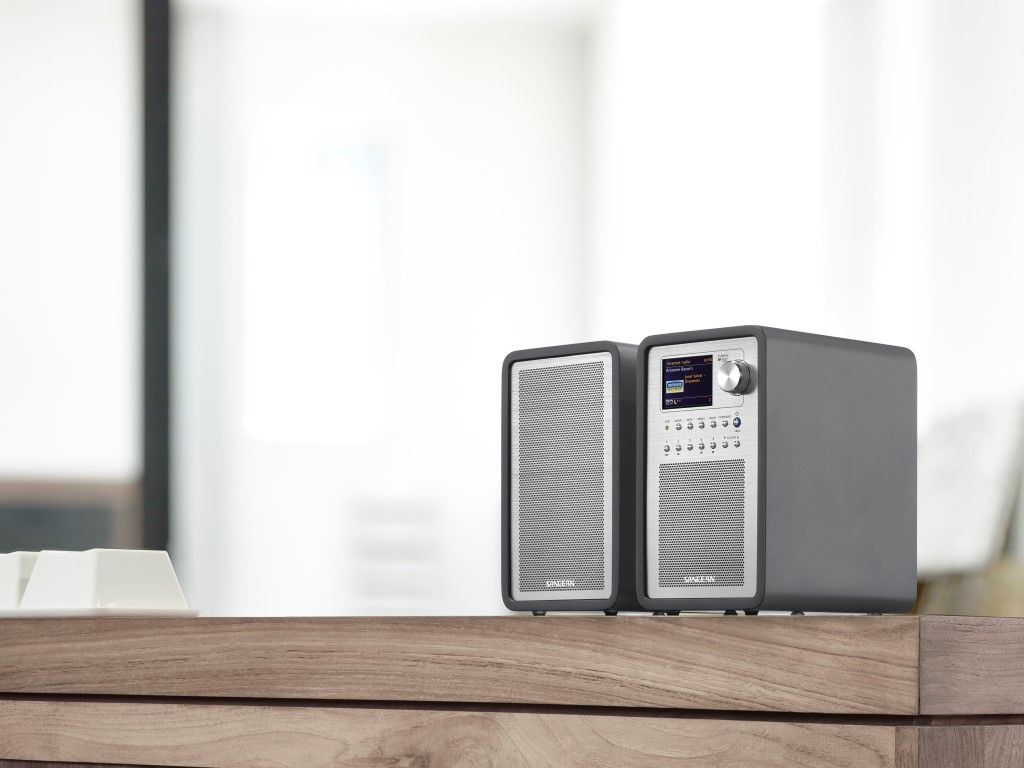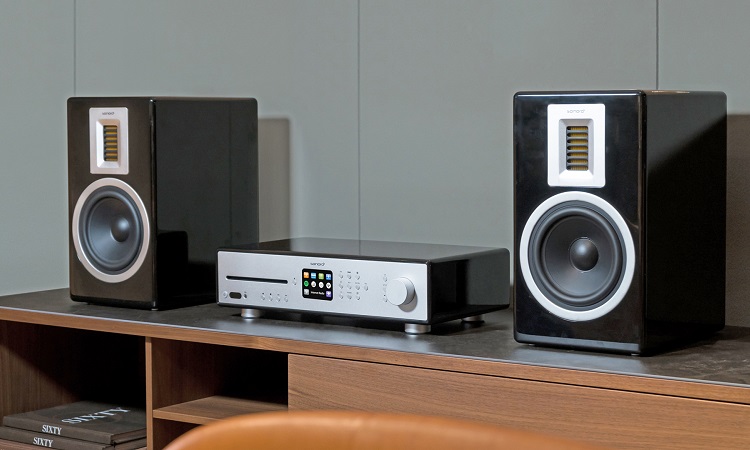The German audio company Sonoro is known for its multifunctional and well-built table radios, which only need a power cord to make music. About a year ago Sonoro launched the Maestro. The Maestro is an amplifier, tuner, DA converter, streamer and CD player and the user only needs to connect two passive speakers. Apparently Sonoro also wants to participate in the market of separate audio components because the company released its first speakers this summer. The Orchestra is a passive two-way bass reflex speaker that should be the perfect companion for the Maestro. In this test we let the Maestro conduct the Orchestra. How is the attempt of table radio brand Sonoro to compete in the crowded market of individual audio components? Â
Sonoro: German audio company specializing in table radios
It in 2006 Audio company Sonoro, founded and based in Neuss, Germany, mainly produces table radios, all of which are equipped with a multitude of functions. The company makes mono models, intended for a bedside table, but also more ambitious stereo models. About three months ago we had the Prestige model at home. The Prestige is a complete three-way system with built-in speakers. For a table radio, the Prestige has a very good sound and we were impressed by the amount of functions and the pleasant operation. Also read our review about the Sonoro Prestige.
Sonoro’s ambitions apparently extend beyond the construction of table radios. About a year ago, the company released the Maestro, a two-channel amplifier with digital and analog connections (also a turntable input for mm cartridges) and the ability to connect to a computer network. The Maestro is equipped with a CD drive, an FM tuner and DAB / DAB + and, like the Prestige, is also richly equipped with streaming functions, i.e. UPnP with support of the common file formats and codecs, Bluetooth connectivity (aptX, bi-directional ), support for mainstream streaming services and Internet radio.
The main difference between the Prestige and the Maestro is the lack of speakers. Sonoro had no loudspeakers in its portfolio when the Maestro was released. In the first instance, an owner of the Maestro would have to connect speakers from another brand. However, Sonoro recently released its first speakers called Orchestra. The new Orchestra is a passive two-way bass reflex speaker. With this Sonoro has thus brought a complete hi-fi system consisting of separate components to the market.
The pleasant meeting with the Prestige had made us curious about the functionality and quality of Sonoro’s first hi-fi components. When the importer asked us if we were interested in examining the Sonoro Maestro with a few Orchestras, we didn’t have to think twice. In our test room, the Maestro is ready to conduct the Orchestras.
Sonoro Maestro: multifunctional music device, add speakers only
As mentioned, the functionality and operation of the Maestro is very similar to that of the Prestige. The included IR remote control is exactly the same as that of the Prestige. There are also differences. The Maestro has no alarm functions, well, it is also not a clock radio or table radio, like the Prestige and all other models from Sonoro. The Maestro also has more front controls than the Prestige, so most functions are directly accessible.
No, the Maestro is therefore not intended for placement on a bedside table. With the Maestro, Sonoro’s ambition extends beyond placement on a bedside table. Alarm clock radios also do not have a two-channel class D amplifier on board that 100 Watts at eight ohms and 170 Watts at four ohms can deliver with a frequency range of 24 Hz to 20 kHz. The Maestro also features a turntable input for mm elements. Most users do not have a turntable next to their bed.
Another prominent difference from Sonoro’s other models is the fact that the Maestro features the ability to adapt the sound to the room. A new room optimization app allows the user to adapt the sound of the Maestro to the acoustic conditions of the listening room. The app uses the built-in microphones of the smartphone for the measurement and therefore currently only works with Apple’s iPhones, because, according to the manufacturer, only then can proper functioning be guaranteed. We did not have an iPhone available so we did not test this function.
Otherwise Sonoroâ ?? ?? s Maestro a feast of recognition for those who have already played with the Prestige or another stereo model from Sonoro. A 2.8-inch TFT color screen is placed centrally on the front. The radio enthusiast can choose from three types of radio. First of all, the classic analog FM radio (96, 5 MHz â ???? 108 MHz). An extendable antenna is of course included. Then there is digital radio in the form of DAB / DAB + (Band III, 174. 928 MHz â ???? 239. 200 MHz) and internet radio with which thousands of stations can be listened to worldwide. The user can search automatically or manually. Ten stations per radio type can be stored for quick access.
Access to the internet is via RJ – 45 LAN connection or via WiFi (with support for WEP, WPA, WPA2 (PSK) and WPS). A setup wizard links the Maestro to wireless LAN.
The Maestro also supports the streaming services Spotify, Tidal , Napster, Deezer, Qobuz and Amazon Music but the user can also send music to the Prestige using DLNA, UPnP or bluetooth (supporting aptX, A2DP, AVRCP and HSP). Incidentally, Bluetooth works bi-directional. This means that a music signal from a smartphone can be sent to the Maestro and at the same time a music signal from the Maestro can be sent to wireless headphones. Preferences can also be saved with regard to streaming services.
On the left of the front of the Maestro is a slot-in CD drive installed that can read regular pressed CDs, CD-Rs and CD-RWs.
Sonoro Maestro: connections
On The following connections can be found on the back of the Maestro:
A cinch line input with a sensitivity of 1 Volt A 3.5mm jack plug input with a sensitivity of 300 mVolt An optical input (Toslink) that accepts PCM signal up to a resolution of 24-bit/96 kHz One coaxial input (S / PDIF), also for PCM signal up to 24-bit/96 kHz A rotary table input for mm elements with a sensitivity of 5 mVolt (47 kOhm) A preamplifier output that can output up to 2 Volt rms (1.5 kOhm). This output is configurable and can therefore also be used to connect a subwoofer, for example. The Maestrro offers the possibility to adjust the crossover frequency so that the subwoofer is seamlessly integrated into the system. A USB input that supports FAT 16 and FAT 32 storage media can play. According to the manual, the Maestro (like the Prestige) can only read USB sticks, not USB HDDs. Many modern streamers can read the folder structure of large USB storage media with NTFS file system. The Maestro cannot do that. NB: this is purely about the file system, not the storage capacity. A 1 TB USB stick formatted in FAT 44 was read and played without interruption. A single pair of speaker terminals, suitable for speakers between four ohms and sixteen ohms. A 3.5 millimeter jack socket for headphones is placed on the front.
In a nutshell, the Maestro is quite a fully equipped amplifier with the necessary built-in sources that has enough connections to connect other sources. If you don’t want to play vinyl, you don’t need any other components apart from loudspeakers (we’ll leave cassette tapes and tape reels out of consideration). The suggested retail price of the Maestro is 1. 300 Euro and it is available in black and white and in a matte graphite version.
We’re going to take a closer look at the Orchestra.
Sonoro Orchestra: two-way bass reflex speaker with AMT
The Orchestra is not small and it is not light either. Sonoro’s first speaker is 239 x 288 x 365 millimeters in size (W x D x H) and weighs approximately ten kilograms. Considering its dimensions and weight, the loudspeaker must be placed on a solid and stable surface. The bass port is located on the back and Sonoro includes foam plugs to dampen the bass if necessary.
The rectangular cabinet is handmade from MDF and has the necessary internal reinforcements in the form of a matrix. The corner lines are rounded. The cabinet is finished in high-gloss, optionally black, white or matt graphite. Sonoro not only packs the Orchestras very thoroughly, but also supplies a pair of gloves so that the speakers remain clean when unpacking and setting up. Yes, the black version, which is in our test room, is sensitive to fingerprints and dust, like all black high-gloss surfaces.
The Orchestra has a removable and magnetically attachable front cover. In a room with a little dimmed light, the loudspeaker is hardly noticeable when the fronts are in place. When the fronts are removed, the aluminum frame of the drivers is visible, but that does not alter the fact that the Orchestra has a modest appearance, even without the front. The loudspeaker does not seem to want to attract attention with its appearance.
The Orchestra’s midrange / woofer has a diameter of 170 millimeters and has a cone of PE-coated paper. The tweeter is an Air Motion Transformer (AMT) with a neodymium magnet. The active surface erlak is 85 cm2. AMT’s are different from “conventional” ???? dome tweeters in that AMT’s have a very light membrane and a larger surface to move air. Partly for this reason, AMTs are able to pick up lower than dome tweeters, allowing a designer to lower the crossover frequency between drivers, below the frequency band in which human hearing is most sensitive. Sonoro specifies a frequency range of 45 Hz to 28 kHz (at level -6 dB). The specified sensitivity is 85 dB (2, 83 Volt / 1 meter) and the impedance is four ohms.
Some photos from the manufacturer show an arrangement used in violates the instructions in the supplied Orchestra manual. Because the bass port is placed at the back, the Orchestra must be at least half a meter away from the wall behind it. Speakers that have a bass port on the back cannot be placed tightly against a wall. It is therefore not advisable to place the Orchestras on a sideboard. The distance to the wall behind is then too small, even with foam plugs in the bass port. It is not for the first time that we have to note that a manufacturer’s Marketing and Photography Department understands nothing about technology and acoustics.
Finally, the Orchestra features a single pair of rigid insulated speaker terminals that accept banana plugs and bare wire.
The Orchestra is available in a black, white or matte graphite version and costs 1. 000 euros per pair.
We are going to connect the components in our test environment.


